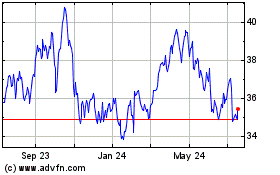BP Earnings Flat as Production, Strong Trading Offset Lower Oil Prices -- 2nd Update
July 30 2019 - 8:02AM
Dow Jones News
--BP reported an underlying replacement cost profit of $2.81
billion, beating forecasts
--The company maintained its interim dividend at 10.25 cents a
share
By Sarah McFarlane and Oliver Griffin
BP PLC's profit held steady in the second quarter with a rise in
oil-and-gas production, and strong trading results that helped
offset lower commodity prices, the company said Tuesday. The
results exceeded peers who suffered a fall in profits for the
period.
London-based BP said its replacement cost profit--a number
comparable to the net income that U.S. oil companies report--was
$1.78 billion in the second quarter, compared with the $1.79
billion reported for the same period a year earlier. Its underlying
profits were similarly steady at $2.81 billion, which was higher
than analysts expected. A company-compiled consensus of 20
analysts' estimates had forecast underlying replacement cost profit
at $2.46 billion.
BP shares were up about 3% in early trading in London.
Production rose 4% to 3.8 million barrels of oil equivalent a
day, but the company warned that output is likely to be lower in
the third quarter as a result of maintenance activities and the
impact of Hurricane Barry on operations in the U.S. Gulf of Mexico.
The hurricane caused 14 days of production outages in July, Chief
Financial Officer Brian Gilvary said.
The results help cement BP's recovery from the Gulf of Mexico
oil spill in 2010 and the oil price collapse in 2014.
"After navigating rocky waters, BP is now plain sailing," said
Bernstein analyst Oswald Clint.
Royal Dutch Shell PLC, Exxon Mobil Corp. and Chevron Corp. are
all due to report results later this week.
Last week, French energy giant Total SA and Norway's Equinor ASA
both announced declines in earnings for the second quarter, citing
lower oil-and-gas prices. Brent oil prices averaged $69 a barrel
for the quarter. While this is up from $63 a barrel the previous
quarter, it was lower than the $74 a barrel for the same period a
year ago. BP noted that European and Asian gas prices were around
40% lower than they were a year ago.
Underlying replacement cost profit before interest and tax in
the company's upstream business--the part of BP that produces oil
and gas--fell slightly to $3.41 billion, from $3.51 billion in the
year-earlier period.
In the U.S., BP is the largest marketer of natural gas.
BP said its operating cash flow, excluding payments related to
the 2010 Deepwater Horizon oil spill, came in at $8.2 billion,
while net debt rose to $46.5 billion. The company paid $1.4 billion
in connection to the oil spill in the Gulf of Mexico as part of its
$20 billion settlement with the U.S. government struck in 2015. The
settlement requires the company to make annual payments through to
2032.
BP says it is on track to reach its goal of selling $75 billion
of assets by 2020. The company's short-term plan is to divest $10
billion of assets in 2019-2020. So far, it has sold assets worth
around $1.5 billion. It is in talks to sell onshore U.S. gas assets
but some deals are taking longer, Mr. Gilvary said.
The asset sales could also help boost future dividends.
"We'll still get $4 to $5 billion done this year and of course
as we get those disposals away that will derisk the balance sheet
and create space for looking at further distributions in the second
half of this year," Mr. Gilvary said.
Write to Sarah McFarlane and Oliver Griffin at
sarah.mcfarlane@wsj.com and oliver.griffin@dowjones.com
(END) Dow Jones Newswires
July 30, 2019 07:47 ET (11:47 GMT)
Copyright (c) 2019 Dow Jones & Company, Inc.
BP (NYSE:BP)
Historical Stock Chart
From Aug 2024 to Sep 2024

BP (NYSE:BP)
Historical Stock Chart
From Sep 2023 to Sep 2024
